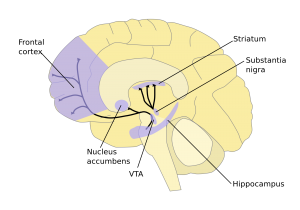Gene Therapy for Parkinson’s Disease

Dopamine Pathways
In two more years, the idea of clinical gene therapy will be a half-century old. Yet, during this time successes have been elusive—a formula dependent on placing the right gene at the right place at the right time and for a disease that has a potential for a commercial bonanza. Parkinson’s may be the disease with an incentive: 10 million sufferers worldwide; one million in the US; 60,000 new diagnoses annually; US cost, $25 billion. This piece describes a gene therapy strategy, originally from the University of California at San Francisco, and now with Voyager Therapeutics (Cambridge, MA) to insert the human gene for aromatic L-amino acid decarboxylase (AADC) into a viral vector and then inject it into putamen of the brain. AADC is the enzyme that converts levodopa to dopamine. The description here doesn’t say what the vector will carry other than the AADC gene, nor whether or not the protocol will use producer cells, nor what the vector’s propensity is for transforming the target cells, but upon all these matters success will hang. MORE
Image Credit: Wikimedia.commons


